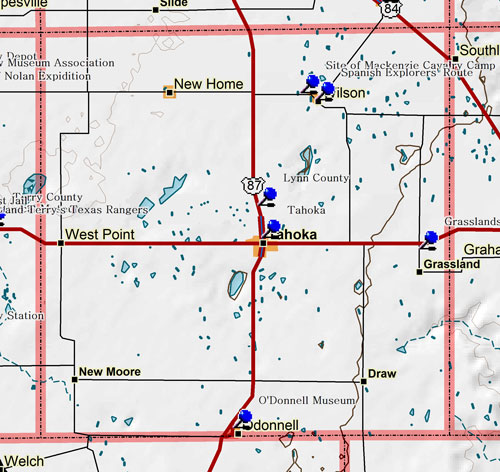|
Marker Title: Grasslands
Address: 2 mi. N on FM 212
City: Grasslands
County: Lynn
Year Marker Erected: 1970
Marker Location: From Tahoka, take U.S. 380 E to Junction of U.S 380 and FM 212. OR 2 mi. N of Grasslands Community on FM 212
Marker Text: One of first land patents in South Plains, lying along a well-marked Indian trail used by explorers, U.S. Army, and (after 1880) the stages and freighters northbound from Colorado City. Grasslands Ranch (named for an estate of President Cleveland) was established 1888 by Enos L. Seeds, the 1889-1900 postmaster, who erected a fine frame house and first trading post on South Plains. Mrs. Seeds was the first permanent white woman resident in county. Nearby is grave of area's first-born white child (a son of Mr. and Mrs. Todd Wilson). Community name is now Grassland. (1970)
Marker Title: Lynn County
Address: 3 mi. N on US 87
City: Tahoka
County: Lynn
Year Marker Erected: 1936
Marker Location: from Tahoka, take U.S 87 about 3 miles north
Marker Text: Formed from Young and Bexar territories; created August 21, 1876; organized April 15, 1903. Tahoka, county seat. (1936)
Marker Title: Lynn County
Address: Courthouse Square, US 87 City: Tahoka
County: Lynn
Year Marker Erected: 1970
Marker Location: Courthouse Square, Highway 87, Tahoka
Marker Text: Created 1876 from Bexar Territory. Name honors G.W. Lynn, "One of those who baptized the altar of Texas with life blood at the Alamo". Tahoka Lake and Double Lakes Springs were watering places on Indian, Spanish, U.S. Army and cattle-driving trails. This was home land of nomadic Indians; visited by Spaniards, 1500s-1800s; used by New Mexicans grazing large herds of sheep in 1860s; site of last great buffalo hunts and the U.S. Cavalry's drive against Comanches, 1874-1877. Last cowboy-Indian skirmish occurred 1879 at Double Lakes. Earliest open-range cattlemen settled here in 1880s. First schools, Lynn and T-Bar, opened in 1902. In April 1903, county was organized, with Tahoka as county seat. The first officials: M.L. Elliott, county judge; S.N. McDaniel, county and district clerk; C.H. Doak, sheriff and tax assessor; W.E. Porterfield, surveyor; J.E. Ketner, H.E. Baldridge, B. Humphries, and W.T. Petty, commissioners. The Santa Fe Railroad built to this point in 1910. This has since become a major agricultural area, ranking among top ten cotton counties in Texas-- and one of the top twenty in the United States. (1970)
Marker Title: Site of Mackenzie Cavalry Camp
Address: SH 211, west city limits in roadside park
City: Wilson
County: Lynn
Year Marker Erected: 1967
Marker Location: SH 211, west limit of Wilson in Roadside Park
Marker Text: At or near this spot, Colonel Ranald S. Mackenzie, with two companies of United States 4th Cavalry, was overtaken on Dec. 4, 1874, by a snowstorm. Forced to spend the night here without wood or water, or grass for the horses, troops called this the most miserable night of their duty in the Southwest. Several horses froze to death. MacKenzie was hunting here for straggling Indians, during last weeks of 1874 campaign to confine tribes to reservations. On Dec. 5 his troops reached Tahoka Lake, where they found shelter under a cliff. (1967)
Museum Name: O'Donnell Museum, Inc.
Mailing Address: P.O. Box 545
City: O'Donnell
Zip Code: 79351
Street Address: 8th Street and Doak Street
Area Code: 809
Phone: 428-3719
County: Lynn
Marker Title: Spanish Explorers' Route
Address: SH 211, west city limit in roadside park
City: Wilson
County: Lynn
Year Marker Erected: 1967
Marker Location: SH 211, west limit of Wilson in Roadside Park
Marker Text: A prehistoric road discovered and used by Indians, Spaniards, United States Army units, and cattle drovers. It crossed the Llano Estacado from Gholson Spring (7 mi. E. of present-day Slaton), to Tahoka Lake (3 mi. S. of Wilson), then to Tobacco Creek, Big Spring, and the North Concho. Here passed many 17th century Spanish visitors: Father Salas, coming from New Mexico in 1629 on pleas of Jumano Indians to preach to them; Captains Hernan Martin and Diego del Castillo, exploring in 1650; Captain Diego de Guadalajara, seeking pearls and other treasure, in 1654. Incise on back: Historian - Dr. W.C. Holden Recorded Texas Historic Landmark - 1967
Marker Title: Tahoka
Address: 1612 Lockwood
City: Tahoka
County: Lynn
Year Marker Erected: 1974
Marker Location: 1612 Lockwood, Tahoka
Marker Text: In Dec. 1902, over 100 people met around a bonfire in a ravine to the southwest of Tahoka Lake and voted to petition for county organization and to select a townsite for a county seat to be named "Tahoka," an Indian word meaning "fresh water," Early in 1903, B.G. Sweet, Jack Alley, and W.T. "Bill" Petty organized the Tahoka Townsite Company. Sweet surveyed and platted the town, and he and L.E. King established the first mercantile store opposite the southwest corner of the public square. County elections were held on April 7, 1903, and the Tahoka Post Office opened on April 30, with Fannie N. Henderson as postmaster. Tahoka soon boasted a 2-story frame courthouse, school, two churches, a hotel, and several businesses, including a newspaper, "The Lynn County News," first published on Oct. 9, 1903, by Otis and Inez Lilly. In 1906, a bank and a cotton gin were built. The Santa Fe Railroad was extended from Slaton to Tahoka in 1910, and for several years Tahoka was one of the largest cattle shipping points in the nation. The community was incorporated on June 13, 1915, and J.E. Stokes elected mayor. Tahoka serves as a trade center for Lynn County farmers and ranchers. (1974)
|

